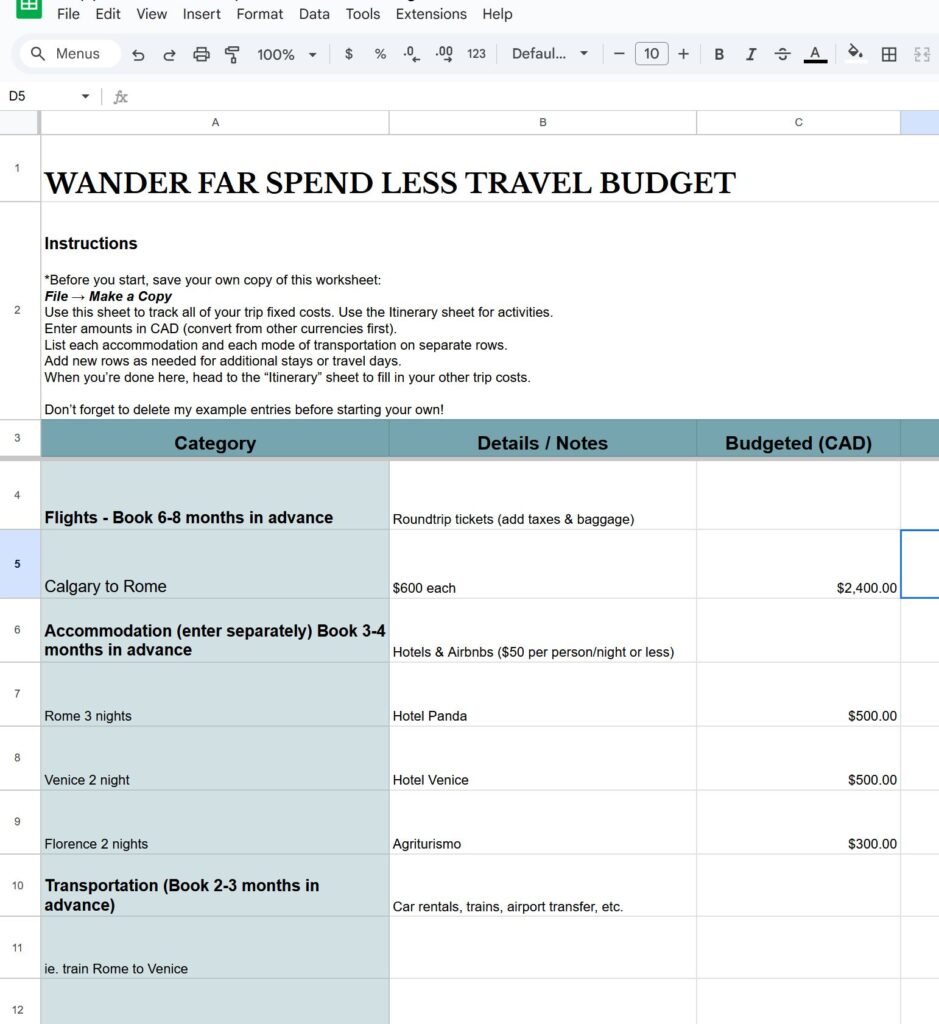Family Travel That Doesn’t Break the Bank
Family travel can feel expensive, but it doesn’t have to mean going into debt. I’m going to show you how to budget for family travel.
With a bit of planning and a clear budget, you can take memorable trips and feel confident about what you’re spending. The key is being realistic about what works for your family and building your plans around that, not the other way around.

There’s nothing better than watching the plane take off knowing your trip is completely paid for. And saving for a trip can be an incredible lesson for your kids, too. It teaches delayed gratification, tough in the moment, but so worth it when you’re all on that adventure together.
Get them involved in the process! Maybe they sell old toys or sports gear to add to the travel fund, or agree to fewer takeout nights so you can save more for the trip. “Save first, then buy” is a lifelong skill and travel is the perfect way to show why it’s worth it.
This post will walk you through how to build a practical trip budget and use my Travel Budget Worksheet (a free Google Sheet you can download) to make it easy.
Choose a Destination
Start with the fun part, picking where you’d love to go.
Maybe you already have a city or country in mind, or maybe you’re torn between a few ideas. Either way, choose one destination to start and begin researching the approximate cost of flights and accommodation.
I often choose where we’re going next based on flights alone. If I find a flight deal or if I know I can get us there affordably that’s where I pick. I try and always keep our flights to under $1000 each. Ideally, I’m looking for $500-$700 each.
If you’re flexible on destination try using Google Flights Explore. See my post How to Use Google Flights Explore to Find Affordable Trips.
Don’t worry about perfection here. This first step gives you a rough idea of what that trip might cost for your family.
Start Plugging In Numbers
Once you have an idea of your destination, open the Travel Budget Worksheet and start filling in what you find.

Estimate your flights, accommodation, transportation, meals, and activities. This is where the reality check comes in.
Ask yourself:
Is this total affordable for us?
If not, could we adjust the destination, shorten the trip, or travel at a different time of year?
This process helps you plan travel that fits your finances, not the other way around.
Refine the Details
You’ve figured out where you’re going and have committed to the trip! Yay! This is the exciting part. Now you’ll start filling in the budget with every last cost you can think of. Don’t leave anything out. Estimate food costs, what you’ll spend on souvenirs, travel insurance, airport parking – it’s all part of travelling and you need to budget for it. Not sure what to budget for? My Trip Planning Guide walks you through everything you need to think of when booking a big trip.
I always build in a little buffer for the unexpected (because something always pops up).


If you’re a family of five like us, small swaps like choosing a hotel with free breakfast, or mixing restaurant meals with groceries make a big difference.
Start Saving Now
You’ve got your budget now and it doesn’t have to be exact, but you have a number in mind. Maybe it’s $7,000, $10,000, or $15,000. Whatever it is, now’s the time to figure out where that money will come from.
Because when you step onto that plane, I want your trip to be completely paid for.
Let’s say your trip will cost $10,000 and you’re leaving in 10 months. Working backwards, that means you’ll need to save about $1,000 a month. So how do you make that happen?
Here are a few ideas:
Save an extra $400/month through intentional spending cuts.
Trim your grocery bill by $200/month with meal planning or discount stores.
Sell outgrown kids’ gear, unused furniture, or clothes you no longer wear.
Use “found money” – tax refunds, bonuses, or cash gifts – to boost your fund.
Pause a subscription or streaming service for a few months.
Use cash-back apps for groceries and gas to stretch your savings further.
Cut out the take-out coffee & restaurant meals
In our family, my husband and I use YNAB (You Need A Budget) to track our spending and savings goals. It’s honestly life-changing (I don’t say that lightly!) and having a separate Travel account keeps everything organized and motivating.


Track As You Go
Once your trip begins, it’s easy to switch into vacation mode and stop thinking about the budget altogether but even staying loosely aware of your spending can make a big difference.
You don’t have to log every single receipt. Instead, just take a few minutes each evening (or every few days) to glance at your spending. Look at your credit card app or jot down rough totals for meals, transport, and activities. This small habit helps you stay mindful of where your money is going and prevents that “how did we spend that much?” feeling once you’re home (which is the worst!).
If you’re under budget in one category, say you saved a bit on meals, you can use that extra room for something fun, like a special dessert or an unplanned activity. It’s about being flexible and intentional, not rigid.
You can also use your Travel Budget Worksheet to check in on your total and note what’s left in your overall trip budget. Even a quick review helps you feel in control.
Review and Learn From Each Trip
After each trip, take a few minutes to look over your totals.
Where did you overspend? Where did you save? And most importantly, what felt worth every penny? How to budget for family travel is something you get better at every time you do it!
Every trip teaches you something new about how your family travels and helps you fine-tune your future budgets. Maybe you realized you’re happy with simpler hotels but can’t live without daily gelato breaks, that’s great to know for next time!
And if you came home on budget, with no travel debt, then you’re officially right on track to start planning the next trip! 😉
Need more guidance on planning your trip? Read my post ‘A Beginner’s Guide to Family Travel on a Budget’.
exploring:
Leave a comment